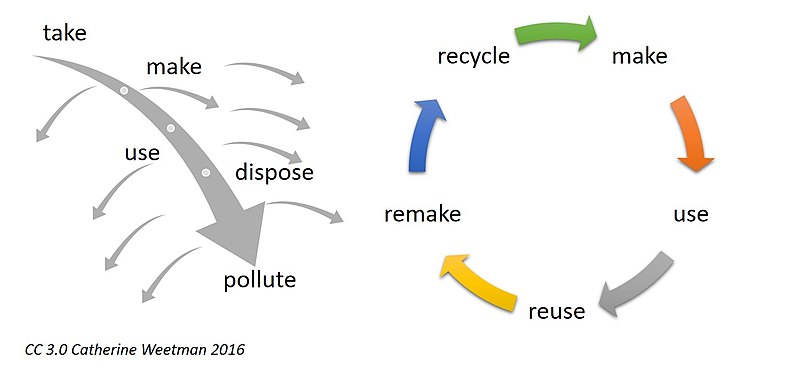Building Back Better: Circularity and BREEAM

|
Contents |
[edit] Introduction
In its work to provide resources for the construction sector, BREEAM has created the online briefing hub, ‘Building Back Better with BREEAM: Supporting the green recovery’. The hub gathers a collection of briefing papers that reflect BREEAM’s position on important issues.
In the area of sustainability and the circular economy (CE), BREEAM recommends resource circularity requirements on energy, water, materials, waste, reuse and recycling as they relate to construction and real estate. Each BREEAM assessment scheme will build upon this position, as outlined in this interactive website, Circularity and BREEAM.
[edit] Defining a circular economy
The concept of the CE goes beyond the three Rs - reduce, reuse and recycle - and aims to maximise total material resource efficiency. CE is a concept in which everything is engineered to be constantly reused or recycled and is in direct contrast to the linear ‘take-make-waste’ concept associated with the disposable economy mindset.
Although the linear economy is associated with job creation based on the continuing demand for new products fabricated from virgin materials, it is also associated with waste creation. In contrast, CE requires rethinking of design, manufacturing, selling, reusing, recycling and consumer ownership to keep resources in use for as long as possible and extract maximum value while producing minimal pollution.
[edit] CE and sustainability
CE in construction and real estate is primarily associated with environmental sustainability. Some circularity initiatives define a scope ranging from operational carbon emissions and local economy to occupant health and local biodiversity. However, it can be difficult to determine the distinctions between circularity and sustainability.
Within BREEAM, CE relates most closely to resource use and supply chains through practical solutions and holistic performance assessment. Practical solutions that incorporate circularity principles are tangible, specific measures that projects can take to improve circularity and improve asset performance (documented through processes such as life cycle assessment, energy and water modelling).
Examples of ‘more with less’ practical solutions include:
- Reuse of resources.
- Efficiency of resource consumption.
- Use of abundant and renewable resources.
- Adoption of durable design
Examples of enabled reuse include:
- Designing for simple disassembly, reuse and recycling.
- Take-back/buy-back.
- Materials banking.
- Materials/product passports.
- Adaptable design.
- Servitisation.
[edit] CE and sourcing
Another practical solution within CE relates to behaviours around procurement. Adopting responsible and ethical sourcing practices may involve a degree of uncertainty, but there are some responsible/ethical sourcing certification schemes designed to reduce unknown supply chain factors.
There are a number of valid initiatives, but BREEAM urges the specification of products with certification sourcing that has been recognised by BREEAM.
Responsible sourcing should include design, construction and in-use life cycle stages.
[edit] Related articles on Designing Buildings Wiki
- BREEAM Life cycle cost and service life planning.
- BREEAM Responsible Sourcing of Materials.
- BREEAM: The Next Generation.
- Building Back Better: Health.
- Building Back Better: Net zero carbon and BREEAM.
- Building Back Better: Resilience.
- Building Back Better: Social impact.
- Circular economy.
- Cradle to cradle product registry system.
- Design for deconstruction.
- Green Guide to Specification
- Reduce, reuse, recycle.
- Whole life costs.
[edit] External resources
About the wiki
Anyone is welcome to use and contribute to the wiki in different ways.
[edit] Engaging with the wiki
You can:
- Contribute to existing articles
- Create articles
- Share articles through social media and other channels
- Contact the CIRCuIT project to let us know what you think and how we can improve
[edit] Add your own content
To contribute to or create an article, you can follow these steps:
- Register as a user
- Read through the editorial policy and guidance on writing and contributing to articles
- See the detailed help page on tips on writing wiki articles
- Try editing a test article
- If editing an article, select 'Edit this article' underneath the article title
- If creating a new article, select 'Create an article'. In the 'Select categories' area, expand the 'Industry context' list and tag 'Circular economy' to add your article to this wiki
[edit] Who is this wiki for?
The articles contain information on implementing circular economy approaches in construction that could be relevant to:
- Architects
- Construction contractors
- Designers
- Developers, owners, investors
- Engineers
- Landowners
- Manufacturers and supplier
- Universities and research
- Urban planners
[edit] About CIRCuIT
The Circular Economy wiki is supported by the Circular Construction in Regenerative Cities (CIRCuIT) project, which is funded by the European Union's Horizon 2020 research and innovation programme. CIRCuIT is a collaborative project involving 31 ambitious partners across the entire built environment chain in Copenhagen, Hamburg, Helsinki Region and Greater London. Through a series of demonstrations, case studies, events and dissemination activities, the project will showcase how circular construction practices can be scaled and replicated across Europe to enable sustainable building in cities and the transition to a circular economy on a wider scale.






